Food and Drinks to Try in Lisbon, Portugal
Posted by Grace on July 26, 2024
In July 2024, we visited Lisbon as part of our around-the-world summer trip. In this post, I'll share my favorite foods and drinks from our stay.
Contents
Food
Cod Cake (Bolinhos de Bacalhau)
What is it?
Cod cakes, or Bolinhos de Bacalhau, are traditional Portuguese snacks made from a mixture of salted cod, potatoes, onions, parsley, and eggs, which are then deep-fried until golden and crispy.
History
Salted cod, known as bacalhau, has been a staple in Portuguese cuisine for centuries, dating back to the Age of Discoveries in the 15th and 16th centuries. Portuguese sailors needed food that could be preserved for long voyages, and bacalhau was the perfect solution. Bolinhos de Bacalhau were created as a way to make a delicious and portable meal from this staple.
Taste
These delightful cakes have a crispy exterior with a soft, flavorful interior. The salted cod gives a unique taste that's both savory and slightly salty, perfectly complemented by the creamy potato and aromatic herbs.
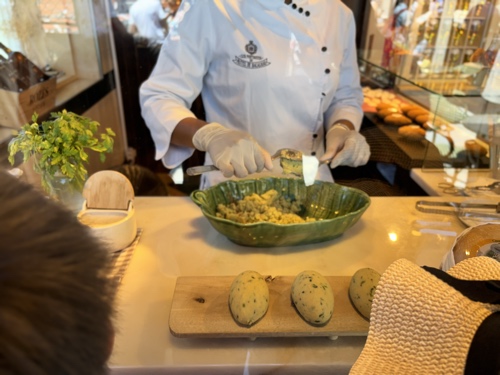 Making of Cod Cake
Making of Cod Cake
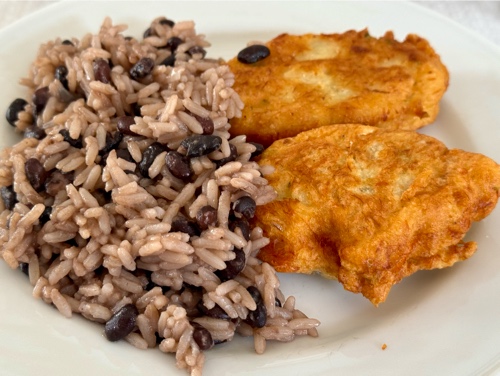 Cod Cake and Rice we had in Faro
Cod Cake and Rice we had in Faro
We had our first one not in Lisbon, but in Faro, and it quickly became a favorite!
 Cod Fish Cake
Cod Fish Cake
Polvo (Octopus)
What is it?
Polvo refers to octopus, a beloved seafood in Portuguese cuisine, often featured in various dishes from grilled preparations to salads.
History
Octopus has been consumed in Portugal for centuries, often associated with coastal communities where fishing is a way of life. Polvo à Lagareiro, a popular dish involving roasted octopus with potatoes, is a traditional recipe that has been passed down through generations.
Taste
My family loves octopus dishes for their tender yet slightly chewy texture and the rich, briny flavor. When grilled, the octopus has a smoky, charred exterior while remaining juicy and tender inside. When fried, it offers a delightful crunch.
We enjoyed a fantastic grilled octopus dish and a fried octopus sandwich at Restaurante O Tasco Do Vigário near the flea market.
One of the top places to try octopus in Lisbon is Quiosque de São Paulo in downtown Cais do Sodré. Run by the same people behind Taberna da Rua das Flores, this kiosk serves meticulously prepared snacks. The octopus salad, featuring cooked octopus with finely diced peppers, onion, coriander, olive oil, white wine vinegar, and salt, is a must-try and arguably one of the best in Lisbon. Though the portions are small, the quality is worth it, and you can always order more or try their legendary fried squid sandwich.
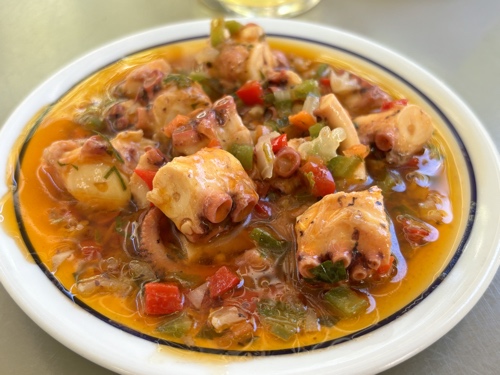 Octopus Salad that we had at Quiosque de São Paulo
Octopus Salad that we had at Quiosque de São Paulo
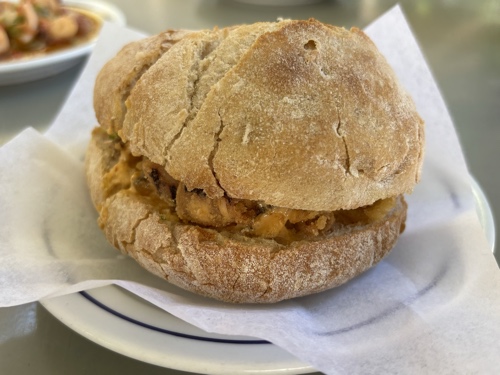 Fried Octopus Sandwich that we had at Quiosque de São Paulo
Fried Octopus Sandwich that we had at Quiosque de São Paulo
 Octopus Rice that we had at Tasco Do Marinheiro
Octopus Rice that we had at Tasco Do Marinheiro
 Grilled Octopus that we had at Restaurante O Tasco Do Vigário
Grilled Octopus that we had at Restaurante O Tasco Do Vigário
Sardinha (Sardine)
What is it?
Sardinhas are fresh sardines, often grilled whole and served simply with a drizzle of olive oil and a sprinkle of sea salt.
History
Grilled sardines, or Sardinhas Assadas, are a highlight of the popular festival, Festa de Santo António, held every June in Lisbon. This tradition dates back to the early 20th century and celebrates Saint Anthony, the city's patron saint. During this time, the streets of Lisbon are filled with the aroma of grilled sardines.
Taste
These small, oily fish are packed with flavor, offering a perfect balance of smokiness from the grill and natural, briny goodness. The flesh is tender and juicy, making for a satisfying bite.
Arroz de Marisco (Seafood Rice)
What is it?
Arroz de Marisco is a Portuguese seafood rice dish similar to a risotto or paella, brimming with a variety of seafood such as shrimp, clams, mussels, and sometimes lobster, all cooked in a rich, flavorful broth.
History
This dish is a relatively modern creation, reflecting Portugal's rich maritime heritage. It showcases the country's abundant seafood and is a popular dish in coastal regions. The concept of combining rice with seafood likely has influences from neighboring Spain and their famous paella.
Taste
This dish is a seafood lover's dream, with each bite bursting with the ocean's essence. The rice is perfectly cooked, absorbing all the savory flavors from the seafood and broth, creating a harmonious and hearty meal.
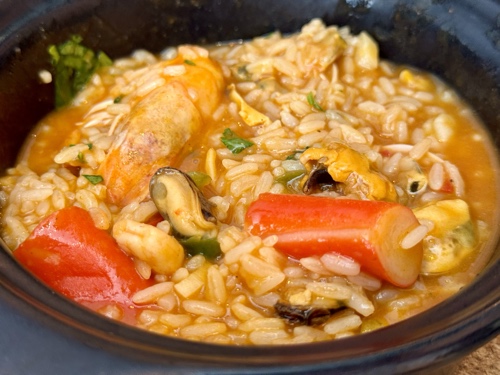 Seafood Rice that we had at Tasco Do Marinheiro
Seafood Rice that we had at Tasco Do Marinheiro
Grilled Seafood
Lisbon is famous for its fresh and flavorful grilled seafood. Here are some popular options you must try:
- Grilled Octopus: Locally sourced octopus, expertly grilled to perfection with a smoky, charred exterior and tender, juicy interior.
- Grilled Sardines: Local sardines are a favorite, especially during the summer festivals. Grilled to a crisp and served with a simple seasoning of olive oil and sea salt.
- Grilled Salmon: While not locally sourced (typically from colder seas), grilled salmon is a popular choice for its rich, fatty texture and slightly smoky flavor. This is my favorite!
- Grilled Bream: This locally sourced fish is another staple, offering a delicate, flaky texture and mild, sweet flavor when grilled.
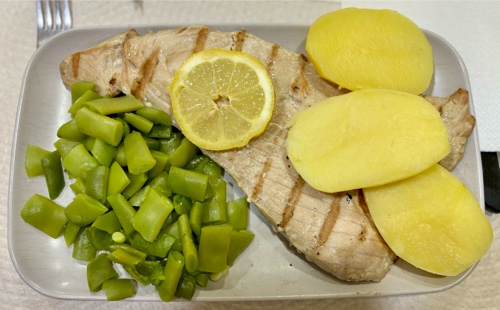 Grilled Tuna
Grilled Tuna
Each type of seafood is enhanced by the grilling process, which adds a unique, smoky flavor while preserving the natural taste and freshness of the fish.
 Grilled Bream that we had at Tasco Do Marinheiro
Grilled Bream that we had at Tasco Do Marinheiro
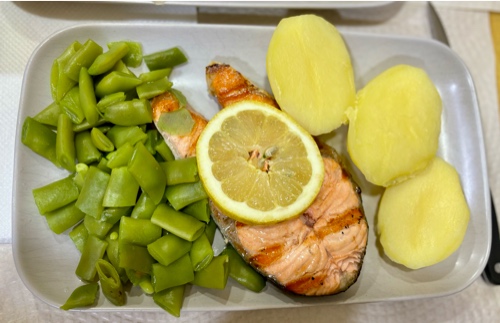 Grilled Salmon
Grilled Salmon
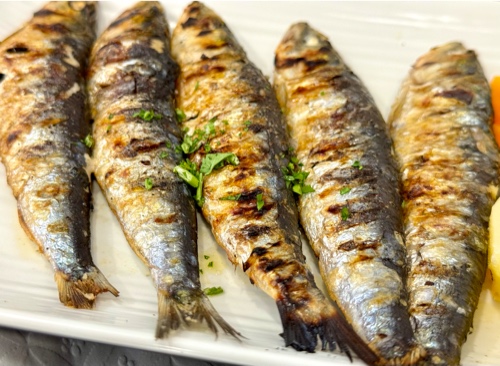 Grilled Sardine
Grilled Sardine
Drinks
Ginja
What is Ginja?
Ginja, also known as Ginjinha, is a Portuguese liqueur made by infusing ginja berries (sour cherries) in alcohol, often with added sugar and sometimes cinnamon.
History
Ginja originated in the 19th century in Lisbon, particularly in the Bairro Alto district. A Galician friar named Francisco Espinheira created the first batch, and it quickly became a popular local drink. Several traditional establishments, such as A Ginjinha, continue to serve this liqueur, preserving its historical significance.
Taste
Ginja is sweet and slightly tart, with a robust cherry flavor and a hint of spice. It is often served in a shot glass or a small chocolate cup, making for a delicious and unique treat.
A Ginjinha is the first bar to sell ginjinha in Lisbon, and is a designated Loja Com História (historic shop). A Ginjinha has been pouring its signature sour cherry liqueur, Espinheira Ginja, since 1840.
 Ginja Shop called A Ginjinha, near Praça do Rossio (Rossio Square)
Ginja Shop called A Ginjinha, near Praça do Rossio (Rossio Square)
 The shop owner pouring Ginja for us at A Ginjinha
The shop owner pouring Ginja for us at A Ginjinha
Enjoying Ginja in a chocolate cup adds an extra layer of decadence, as the rich chocolate melts in your mouth, blending perfectly with the cherry liqueur.
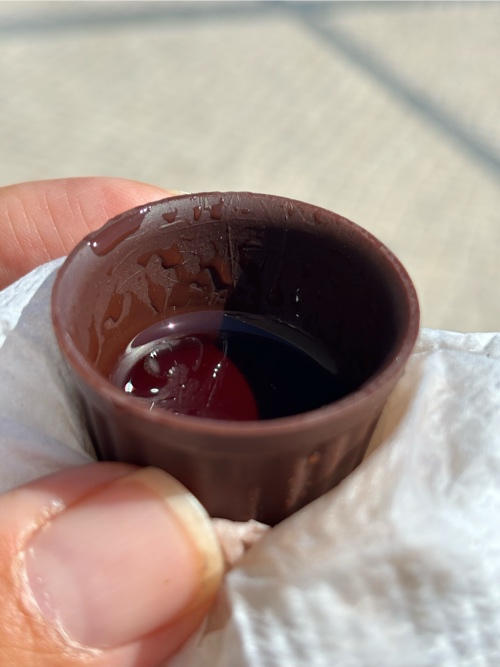 Ginja in Chocolate Cup
Ginja in Chocolate Cup
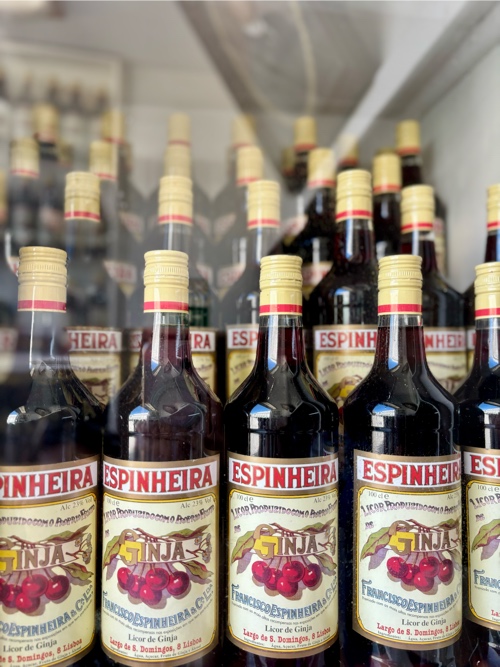 Ginja Bottles displayed at A Ginjinha
Ginja Bottles displayed at A Ginjinha
Sangria
What is Sangria?
Sangria is a popular Spanish and Portuguese punch made with red or white wine, mixed with various fruits, a sweetener, and sometimes a splash of brandy or other spirits.
History
Sangria has roots in the Iberian Peninsula dating back to the Middle Ages. It became particularly popular in the 18th and 19th centuries as a refreshing drink for social gatherings and fiestas. The name "sangria" comes from the Spanish word for "blood," referring to its typically deep red color.
Taste
Sangria is refreshing and fruity, with the wine providing a smooth base complemented by the sweetness and slight tartness of the mixed fruits. It's perfect for enjoying on a warm summer day.
Sweets
Pasteis de nata (Egg Tarts)
Pasteis de nata is literally everywhere in Portugal. These famous custard tarts have a flaky, buttery crust filled with a rich, creamy custard that's caramelized on top, creating a perfect balance of textures and flavors.
History
Originating from the Jerónimos Monastery in the 18th century, these tarts were created by monks who used egg yolks left over from starching their clothes. The recipe was later sold to the nearby Fábrica de Pastéis de Belém, which continues to make the original version to this day. According to local legend, Pastéis de Belém, a bakery next to the Jerónimos Monastery, holds the original recipe for these tasty tarts. It’s the most famous spot in Lisbon to eat pastéis de nata and is an absolute must when you visit. Since 1837, locals and tourists alike have been lining up to snag a box of custard tarts to eat in the café or on the go. As the original, Pastéis de Belém is still an iconic spot in Lisbon to enjoy a delicious custard tart in a charming and lively atmosphere.
Another excellent spot to try these tarts is Manteigaria - Pastéis de Nata Factory. Located in the Time Out Market and other locations around the city, Manteigaria is renowned for its perfectly balanced custard tarts with a crispy, flaky crust. Watching the tarts being made fresh adds to the experience, making it a must-visit. The price of a Pastel de nata is a little more than 1 euro, making it an affordable and delightful treat.
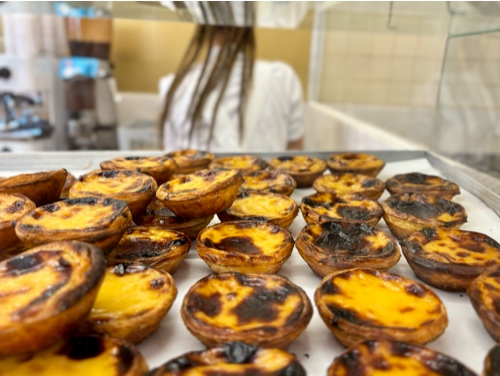 Egg Tarts at Pastéis de Nata Factory
Egg Tarts at Pastéis de Nata Factory
Taste
I found the taste of Pasteis de nata in Portugal a lot sweeter than the ones sold in Chinatown. Some of my Chinese friends even pointed out my photos of Pasteis de nata here and wondered whether they were burned because of the big dark dots. It turns out the dark dots are caramelized sugar. It shows why they are so sweet.
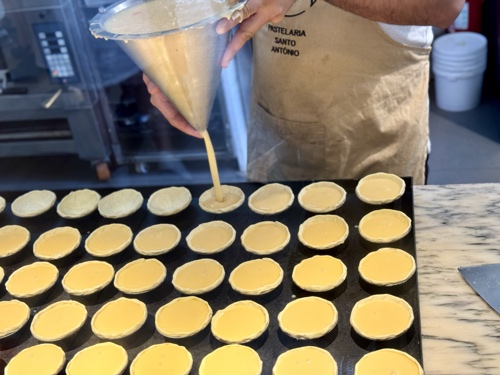 Making of Egg Tarts
Making of Egg Tarts




